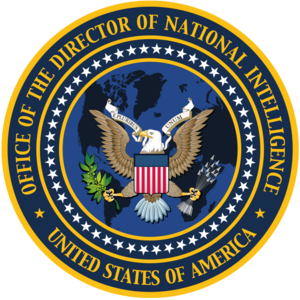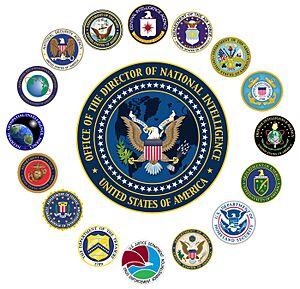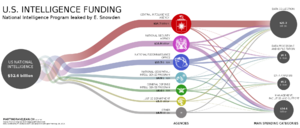United States Intelligence Community facts for kids
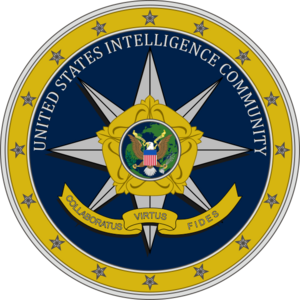
Seal of the US Intelligence Community
|
|
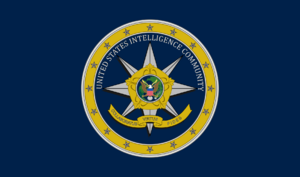
Flag of the US Intelligence Community
|
|
| Agency overview | |
|---|---|
| Formed | December 4, 1981 |
| Agency executive | |
The United States Intelligence Community (IC) is a group of different U.S. federal government agencies. These agencies work together and separately. Their main job is to gather and use information. This information helps protect the United States and guide its relationships with other countries.
The IC includes many types of groups. Some are intelligence agencies. Others are military intelligence units. There are also civilian offices that focus on intelligence and analysis. These offices are part of different government departments.
The Office of the Director of National Intelligence (ODNI) oversees the IC. The person in charge is the Director of National Intelligence (DNI). This person reports directly to the president of the United States. The IC was officially started on December 4, 1981. President Ronald Reagan signed an order called Executive Order 12333 to create it. Later, a law in 1992 officially defined the IC and its member agencies.
In 2010, a newspaper reported on the size of this community. It said that over 1,200 government groups and 1,900 private companies worked on intelligence. These groups were in 10,000 places across the U.S. About 854,000 people had top-secret security clearances. This shows how many people are involved in protecting the country.
Contents
What Does "Intelligence Community" Mean?
The name Intelligence Community was first used a long time ago. It came into use between 1950 and 1953. This was when Walter Bedell Smith was the head of the Director of Central Intelligence.
History of U.S. Intelligence Work
Intelligence is important information. Government leaders need it to make decisions. Agencies collect, study, and share this information. It helps them answer questions and meet their needs.
What does "intelligence" involve? It means:
- Gathering and studying secret information. This helps leaders like the President and military commanders.
- Protecting this information and the ways it's collected. This is done through counterintelligence activities.
- Carrying out secret operations approved by the President. These are done so the U.S. government's role isn't obvious.
The IC works to give helpful insights on important topics. They gather raw information. Then, they analyze it to understand what it means. Finally, they create reports for leaders at all levels. This goes from soldiers in the field to the President in Washington.
When the IC was created, it was given six main goals:
- To collect information for the President and other top officials. This helps them do their jobs.
- To create and share intelligence reports.
- To gather information about threats to the U.S. This includes activities against the U.S. by other countries or terrorist groups. They also work to protect against these threats.
- To conduct special activities abroad. These are secret actions that support U.S. foreign policy. They are planned so the U.S. government's role is not known publicly.
- To handle administrative tasks and support activities. These are needed for their work both in the U.S. and overseas.
- To carry out any other intelligence tasks the President might ask for.
Before the Central Intelligence Agency (CIA) was formed, other groups did similar work. These included several military intelligence agencies. The FBI also played a small part.
How the Intelligence Community is Organized
The Director of National Intelligence (DNI) leads the IC. The DNI's office is called the Office of the Director of National Intelligence. This office helps the DNI guide the entire community.
Who are the Members of the IC?
The IC is made up of 18 different organizations. Here is a list of its members:
| Seal | Organization | Parent organization | Federal department | Date est. |
|---|---|---|---|---|
| Office of Naval Intelligence (ONI) | U.S. Navy | Defense | 1882 | |
 |
Coast Guard Intelligence (CGI) | U.S. Coast Guard | Homeland Security | 1915 |
 |
Bureau of Intelligence and Research (INR) | United States Department of State | State | 1945 |
 |
Central Intelligence Agency (CIA) | Executive Office of the President of the United States | Independent agency | 1947 |
| National Air and Space Intelligence Center (USAF ISR Enterprise) | U.S. Air Force | Defense | 1954 | |
  |
National Security Agency (NSA) / Central Security Service (CSS) |
Department of Defense | Defense | 1952 |
 |
National Reconnaissance Office (NRO) | Department of Defense | Defense | 1961 |
 |
Defense Intelligence Agency (DIA) | Department of Defense | Defense | 1961 |
 |
U.S. Army Intelligence (Office of the G-2) | U.S. Army | Defense | 1977 |
 |
Office of Intelligence and Counterintelligence (OICI) | Department of Energy | Energy | 1977 |
 |
Marine Corps Intelligence, Surveillance, and Reconnaissance Enterprise | U.S. Marine Corps | Defense | 1920 |
 |
National Geospatial-Intelligence Agency (NGA) | Department of Defense | Defense | 1996 |
 |
Office of Intelligence and Analysis (OIA) | Department of the Treasury | Treasury | 2004 |
 |
Intelligence Branch (IB) | Federal Bureau of Investigation | Justice | 2005 |
 |
Office of National Security Intelligence (ONSI) | Drug Enforcement Administration | Justice | 2006 |
 |
Office of Intelligence and Analysis (I&A) | Department of Homeland Security | Homeland Security | 2007 |
 |
National Space Intelligence Center (NSIC) (USSF ISR Enterprise) | U.S. Space Force | Defense | 2020 |
How Intelligence Programs Work
The IC operates under two main types of programs:
- The National Intelligence Program (NIP) covers most intelligence activities. This includes projects and activities for the whole intelligence community. The DNI is in charge of overseeing this program.
- The Military Intelligence Program (MIP) focuses on military intelligence. These are programs for the military branches. They gather intelligence only for planning and carrying out military operations. The Under Secretary of Defense for Intelligence manages the MIP.
Sometimes, the definitions of NIP and MIP can overlap. This happens when military intelligence activities could fit into either program.
Leadership and Structure of the IC
Laws like the National Security Act of 1947 guide how the IC is set up. The way the IC is organized changed a lot in 2004. This was due to the Intelligence Reform and Terrorism Prevention Act.
The IC is like a group of independent parts working together. Before 2004, the head of the CIA was also the head of the IC. But this person didn't have much power over the budgets of other agencies. This limited their influence.
After 2004, the DNI became the main leader of the IC. The DNI's job is to:
- Create and manage the budget for the National Intelligence Program.
- Set goals and priorities for the entire IC.
- Guide how intelligence is collected, analyzed, and shared.
However, the DNI cannot directly control every part of the IC. The DNI only has direct control over their own staff. The other agencies are led by their own department heads. These heads report to the President. Only the head of the CIA reports directly to the DNI.
There have been debates about the DNI's power. This is because of past intelligence failures. For example, the 9/11 Commission and the "WMD Commission" pointed out problems. They questioned how well the IC protects U.S. national security.
Working Together: Interagency Cooperation
In the past, it was hard for different agencies to share information. Rules were in place to limit sharing due to privacy and security worries. Now, there are efforts to help agencies work together better. This includes new technology, structures, and ways of working.
For example, there's a wiki called Intellipedia. It's like an online encyclopedia for security information. New offices and councils have also been created. Laws like the Intelligence Reform and Terrorism Prevention Act of 2004 also help. These changes aim to improve how information is shared across the IC.
How the Intelligence Budget Works
The U.S. intelligence budget is a large amount of money. In 2022, the budget for the National Intelligence Program was about $65.7 billion. This amount has been public since 2007. A law passed after 9/11 required this information to be shared.
A big part of the budget goes to private companies. These companies provide technology and services. This includes help with analysis. The exact details of how the money is spent are kept secret. This is to protect national security. The budget covers salaries for many people. It also pays for things like spy satellites, aircraft, and computer systems. It also funds spies and intelligence analysis.
In 2013, a newspaper published a summary of the IC's secret budget. This was a rare look into how the 16 spy agencies use their money. Experts said this level of detail had never been seen before. Some people believe that knowing these budget details helps the public understand intelligence spending.
Who Oversees the Intelligence Community?
Many groups watch over the Intelligence Community. Both the President's branch of government and Congress have oversight duties.
The President's side has groups like the President's Foreign Intelligence Advisory Board. Congress also has special committees. These include the United States House Permanent Select Committee on Intelligence and the United States Senate Select Committee on Intelligence. These committees make sure the IC is doing its job correctly. They also help decide on the IC's budget each year.
More to Explore
 In Spanish: Comunidad de Inteligencia de los Estados Unidos para niños
In Spanish: Comunidad de Inteligencia de los Estados Unidos para niños
- UKUSA Agreement, and other members of Five Eyes:
- United Kingdom Intelligence Community
- New Zealand intelligence agencies
- Intelligence services in Canada
- Australian Intelligence Community
- List of intelligence agencies
- National Security Act of 1947
- United States National Security Council


